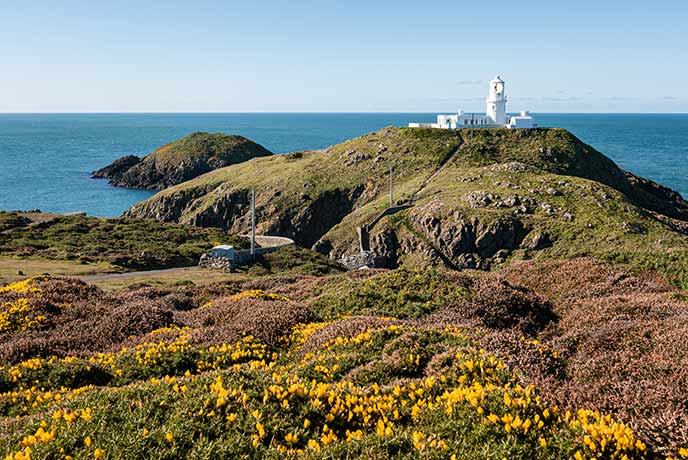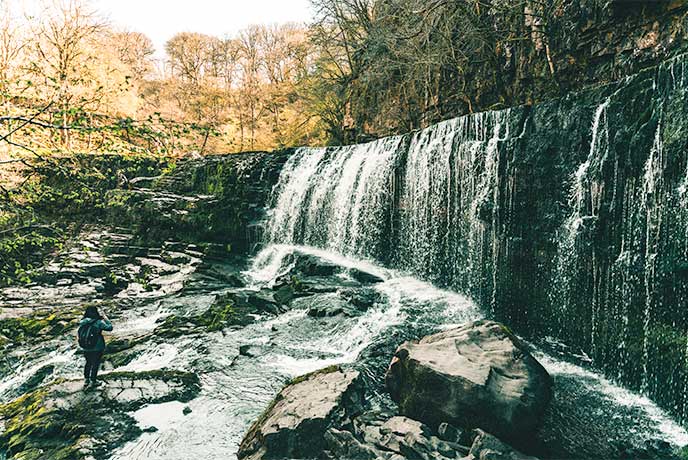From rugged mountains to sandy shores, Wales certainly packs a punch when it comes to dramatic countryside, where myth and legend live on and the next jaw-dropping view is just around the corner – it’s not surprising that such an otherworldly landscape has inspired the likes of JRR Tolkien and his tales of Middle Earth.
Altogether, Wales is home to three national parks, 118 mountains, innumerable beaches, and countless rivers, streams, and waterfalls that cascade through the landscape – that’s a lot for such a small country! Safe to say that the wow factor is immense here, and a holiday exploring these incredible places will create memories that’ll stay with you for years to come.
We’ve put together a collection of just some of the most iconic, dramatic places to visit in Wales – take a look and let us transport you to another world…
Snowdonia (Eryri) National Park
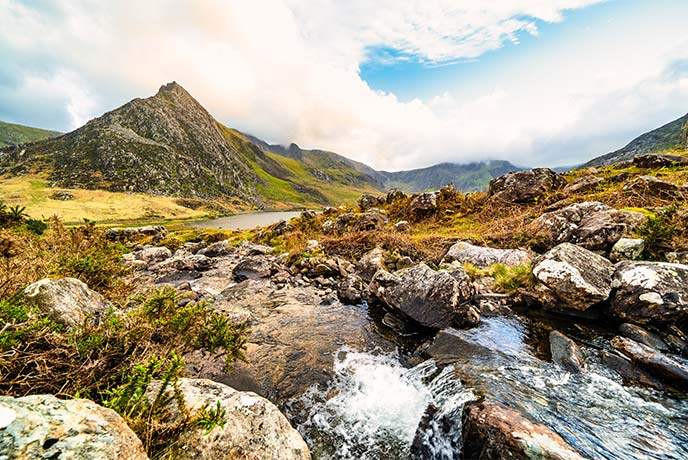
Covering an area of 823 square miles, Snowdonia (or Eryri) is the largest National Park in Wales, and arguably its most dramatic. With nine mountain ranges, 74 miles of coastline, and 11,000 hectares of woodland, there’s so much to see and do, you could easily spend your whole holiday here! Yr Wyddfa (Mount Snowdon) is at the heart of the park and stands at over 3,000 feet, making it the highest mountain in Wales, and you can either walk up it or take the iconic train that climbs the 100-year-old, narrow-gauge railway. At the summit, take time to admire the view at Hafod Eryri, the spectacular visitor centre.
Other highlights of Snowdonia include the 4-mile-long Lake Bala (the longest in Wales and a mecca for watersports), the ruins of Dolwyddelan Castle – an 11th-century ruin with a mountainous backdrop, the impressive Llanberis Pass (a photographer’s dream) and the dramatic Aber Falls, a 37-metre-high waterfall.
The Fairy Glen, Conwy

Tucked away in Snowdonia National Park just 2 miles from Betws-y-Coed, this spectacular spot is well worth a visit for its magical charm. A thickly wooded sheer gorge whose Welsh name, Ffos Noddyn, means ‘deep ditch’, it’s a stunning ravine through which the River Conwy flows, framed along the way by trees creating an emerald, otherworldly air that’s inspired poets, artists, and writers alike.
Steeped in folklore, you’ll be forgiven for expecting nymphs and fairies under toadstools as you walk along the steep and slippery path downwards, passing waterfalls, mossy carpets, uneven rock slabs, and pools as you go. The path may be tricky, but it’s well worth it for the beautiful scenery and cavernous feel. It’s probably best not to do it in wet weather or when it’s dark, and you’ll need to have good gripping footwear.
St Govan’s Chapel, Pembrokeshire
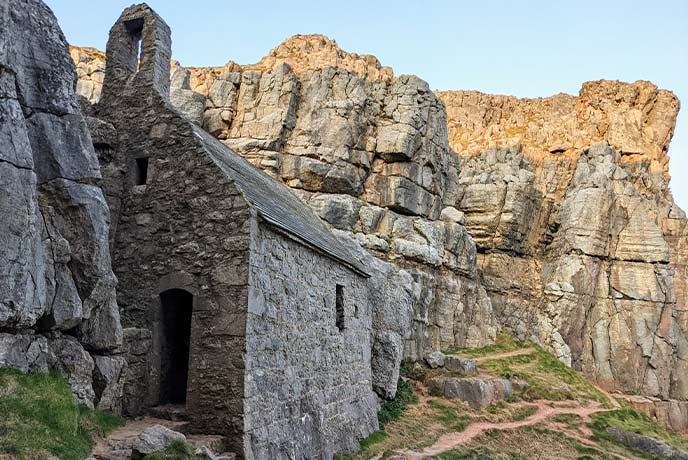
A tiny hermit’s cell built into the side of the cliffs at St Govan’s near Pembroke, St Govan’s Chapel is a mystical medieval church founded back in the 6th century. St Govan himself was said to have been forced here by marauding pirates and took refuge in a cave where he lived for the rest of his life, living off of the fish he caught from the sea and water from a holy well, and warning the local community when pirates approached by ringing a bell. After his death, the site became a place of pilgrimage, and a chapel was built, just 20ft by 12ft in size.
Steeped in mystery and myth, it’s said you can see St Govan’s rib marks on the rocks where he hung on for dear life as the cliffs opened and closed around him to protect him from the pirates’ attack. It is also said that Sir Gawain, King Arthur’s nephew, is buried here. Legend says the water from the well can cure eye problems, while, apparently, if you count the steps up and down from the chapel, they are never the same! St Govan’s Chapel is best visited at low tide and the weather is dry as the steps get slippery and winds can get high around that part of the coast.
South Stack Lighthouse, Holy Island

Set on Anglesey’s most westerly point, South Stack Lighthouse lies on Holy Island, 3 miles west of Holyhead. Perched on the 300ft cliffs of South Stack, the lighthouse itself can be reached by taking the 400 steps down the steep cliffside where you can tour the engine room and climb to the top for amazing views (it’s open Easter to the end of September, 10am – 4pm).
If the steps sound a little daunting, you can still take in the incredible setting from the clifftop, with magnificent views of the Llyn Peninsula, Bardsey Island, and even the Wicklow Mountains in Ireland on a clear day. The cliffs themselves are home to large colonies of seabirds such as guillemots, razorbills, and puffins who breed there in spring as well as the rare chough. Head to the RSPB’s Ellin’s Tower observatory to learn more and make the most of the visitor centre, café, and car park.
Skomer Island, Pembrokeshire

Situated just 1 mile off of the Pembrokeshire coastline, Skomer is a beautiful island. During the months of April and July, charming, clown-faced puffins call Skomer home when they come to breed, but there is plenty of other wildlife that reside here, from ravens and lizards to guillemots and grey seals. Amazingly, a staggering 350,000 breeding pairs of Manx shearwaters live here as well – the largest colony in the world.
Day trips run to the island from Martin’s Haven, giving you hours to explore and watch the wildlife, with the main circular walk taking about 1.5 hours. With beautiful views and flower-strewn grassy plateaus, there’s plenty of opportunity to sit and peer through binoculars, with the Wick the best place to spot puffins. Please note there are 87 steps to climb upon landing and paths can be uneven and rocky. If mobility is a concern, there are lovely boat trips around the island available. There are toilets but no other facilities, making Skomer Island the perfect excuse for a Pembrokeshire picnic.
Brecon Beacons National Park
![]()
At 520 square miles, the impressive Brecon Beacons lie between mid and south Wales and is an International Dark Sky Reserve. Less wild perhaps than Snowdonia, this beautiful park boasts grassy moorland, escarpments clad in heather and sandstone peaks, as well as being home to four mountain ranges; the Black Mountains, the Central Beacons, Fforest Fawr, and the Black Mountain. Famous for its excellent walking, there are over 2,000 miles of public footpaths to discover for yourself.
Highlights of the Brecon Beacons include Hay Bluff, iconic Hay-on-Wye (a picturesque, book-centric town that’s an Instagrammer’s dream), Fforest Fawr (classified as a UNESCO Global Geopark, the first in Wales), the incredible Llyn y Fan Fach, a huge glacial lake, and the oh-so-romantic remains of Llanthony Priory. For a truly magical experience, head to the National Park Visitor Centre in Libanus and take part in one of their amazing dark sky stargazing nights.
Devil’s Bridge and Falls, Ceredigion
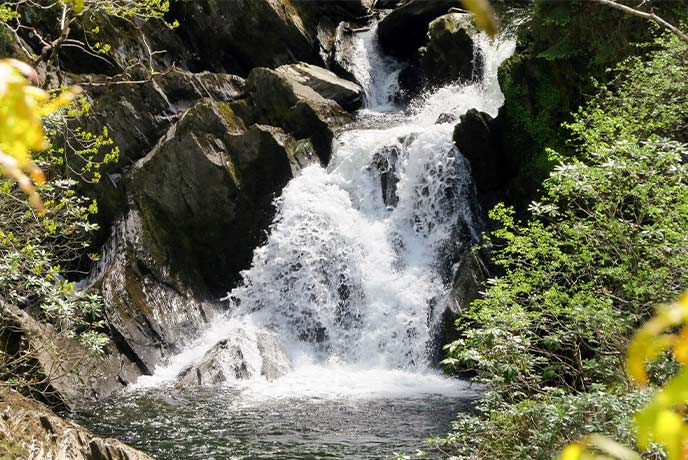
Drawing visitors for over one hundred years, Devil’s Bridge and the cascading Mynach Waterfalls are one of the ‘must-see’ natural wonders of Wales. 12 miles from Aberystwyth, the bridge and falls lie within an ancient wooded gorge, attracting plucky tourists such as the poet Sir William Wordsworth back in the 18th century. Luckily for us, there’s a fantastic nature trail for us to follow these days that leads you into the gorge and takes you to the falls (that boast an impressive 300-foot drop), cascading over five tiers to the bottom.
Make sure to go into Robbers Cave, an old hideout next to the waterfall, before crossing the Devil’s Bridge, which is actually made up of three bridges built on top of each other. Before the falls, you’ll descend Jacob’s Ladder (100 steps) and climb up the other side, so the 45-minute circular walk can be challenging with all the steps. However, there’s a shorter ‘Three Bridges and Punchbowl’ trail that takes 10 minutes. Make sure to wear sensible shoes and dogs must be kept on a lead. Shorter dogs may struggle with the steep steps.
Wales Coast Path

Starting at the border between England and Wales just outside Chester, passing along the north Wales coast, Anglesey, Llyn Peninsula, Snowdonia, Ceredigion, Pembrokeshire, and the south Wales coast, the majestic Wales Coast Path runs over 870 miles in length.
Established in 2012, the path winds its way past sandy beaches, seaside towns and villages, marshes, estuaries, castles, mountains, and dunes – and it’s super easy to dip in anywhere along its route for jaw-dropping views and gorgeous walks. Plan ahead and you can find stretches suitable for all abilities and accessible for wheelchairs and buggies, such as the Millennium Coastal Path from Llanelli to Pembrey Forest, the Mawddach Trail between Dolgellau and Barmouth, and pretty seafronts like Llandudno.
Cefn Sidan Beach, Carmarthenshire

Arguably one of Europe’s best beaches, this 8-mile stretch of sweeping golden sandy beach is simply stunning. Part of the Pembrey Country Park in Carmarthenshire, Cefn Sidan Beach was the first in Wales to achieve the coveted Blue Flag Award. With panoramic views across Carmarthen Bay towards the Gower and home to over 300 shipwrecks with the earliest dating back to 1668 (you can still see the remains of the hull of the SS Paul when the tide is out), it’s a dramatic, otherworldly place to explore.
There are specific zoned areas for swimming, fishing, and kayaking, while the beach is also host to sandcastle competitions, and parakarting and sand yachting events. The dunes that back the beach are a Site of Scientific Special Interest (SSSI) with several trails for walking. There are toilets and a café at the beach entrance, and dogs are welcome between October and April on the main beach.
Elan Valley, Powys
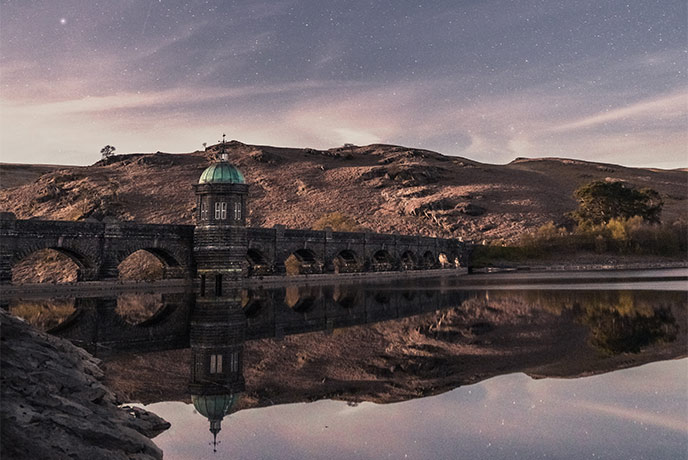
Sandwiched between the Brecon Beacons and Snowdonia and nestled in the heart of the Cambrian Mountains, the Elan Valley is a series of Victorian dams and reservoirs so beautiful they’ll make even the most hardened photographer swoon. Often overlooked by visitors, the valley lies to the west of the market town of Rhayader. Built over 100 years ago, the dams, reservoirs, and 73-mile-long aqueduct in Powys were built to supply clean water to Birmingham, and are still fully functional today.
Accessible by car, it’s one of the most scenic drives you’ll ever take, spanning 12 miles with car parks along the way to stop and take photos – there’s also a visitor centre to explore. Alternatively, there are lots of lovely trails (over 80 miles of them) if you fancy a walk or to go mountain biking. Elan Valley is magnificent whatever time of year you visit, but it’s particularly dramatic after heavy rainfall or during winter when the dams are in full flow. As a Dark Skies Park, it’s also lovely to come once the sun has set on a clear night when it’s possible to gaze at the Milky Way.
Llŷn Peninsula, Gwynedd
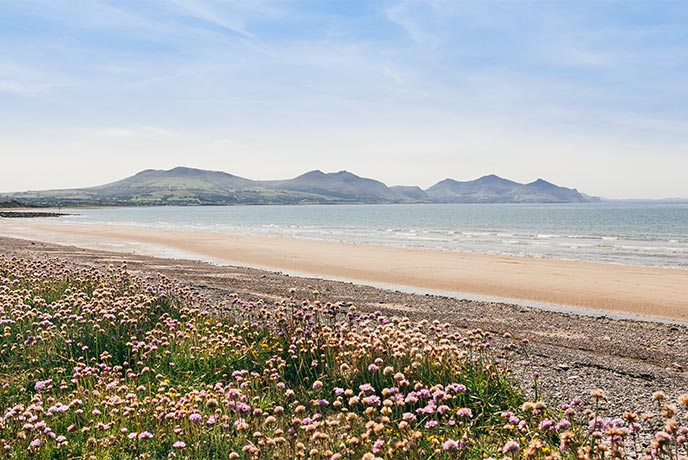
Known as the ‘Land’s End of Wales’, the stunning Llŷn Peninsula is a 16-mile-long sliver of land that’s a designated Area of Outstanding Natural Beauty (AONB) that boasts everything from dramatic, wind-blown cliffs and sandy beaches to tranquil harbours and pretty villages. It’s easy to explore the coastline along the Wales Coast Path, stepping on and off where you will, or head to Nant Gwrtheyrn, a newly-renovated Victorian village and home to the National Welsh Language and Heritage Centre where you can also learn what it was like to live in a Victorian quarry community.
Other highlights include Plas yn Rhiw manor and Porth y Swnt, where you can learn all about the culture and heritage of the Llŷn Peninsula, the stunning village of Aberdaron, and the rocky, dramatic Yr Eifi mountains. Another must is a boat trip to Bardsey Island (Ynys Enlli), known as the ‘Isle of 20,000 Saints’ and a sanctuary for over 300 species of birds.
Caernarfon Castle, Caernarfon
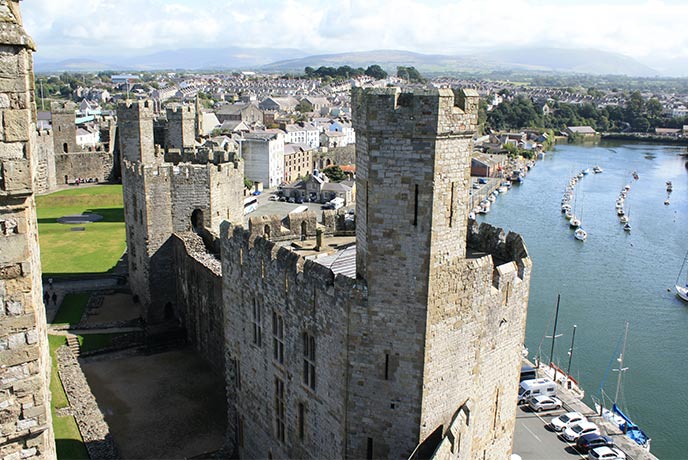
Wales is home to many castles, whether they’re along the coastline or protecting the border from the invading English. Perhaps the most dramatic is the huge fortress of Caernarfon Castle, which dominates the skyline and lies above the bank of the River Seiont. Built during the conflict with neighbouring Welsh princes, it took 47 years to complete and cost a massive £25,000 to build.
A testament to the architectural determination of the Middle Ages, the 18-foot-thick curtain walls, three imposing turrets, and giant King’s Gate make for a rather insurmountable opponent, providing more than one way of keeping invaders out. The Royal Welsh Fusiliers Museum is located within the castle and is well worth popping into, plus there’s a café and gift shop. Family-friendly events take place throughout the summer months, so little ones can get fully immersed in medieval life too.
Pistyll Rhaeadr, Powys
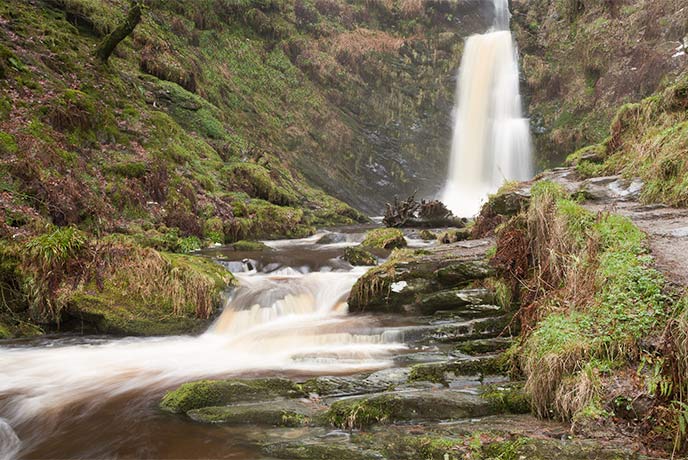
With lots of rivers, lakes, and streams, and not forgetting a fair amount of rain, it’s not surprising Wales has some pretty magical waterfalls. The incredible Pistyll Rhaeadr, which means ‘Spring of the waterfall’ in Welsh, is Britain’s tallest single-drop waterfall, at 240ft (80 metres). Tucked away in the Berwyn Mountains, it’s considered to be the male companion to Cornwall’s St Nectan’s Glen.
To get to it you’ll need to travel down a 4-mile single-track road, but it’s oh-so-worth it for the incredible views and magical atmosphere. It can get busy in summer, so get there early in the morning or late in the afternoon to avoid the crowds, while a visit in autumn or winter will reward you with a more peaceful visit and a more dramatic waterfall.
Barmouth Bridge, Gwynedd
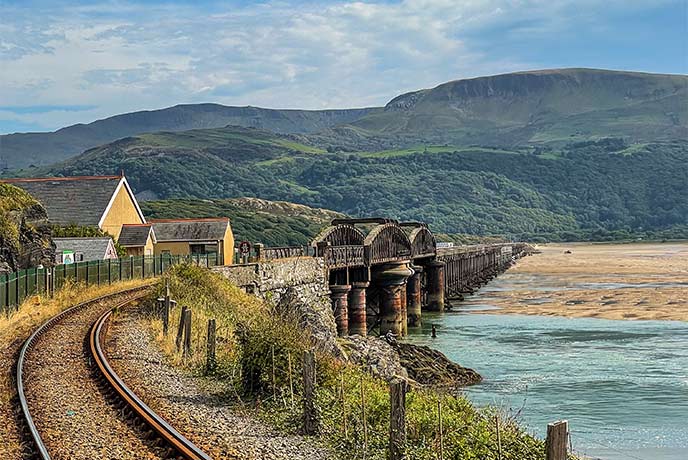
Spanning the Mawddach Estuary, this iconic Grade II* listed wooden railway viaduct is a great spot for awe-inspiring views over the mountains, and beaches and out over Cardigan Bay. The longest viaduct in Wales, it was built between 1864-1867 and had a swing bridge to allow boats to pass through, while today it forms part of the Mawddach Trail, a fantastic 9.5-mile walk between Barmouth and Dolgellau.
There's a small honesty toll to cross the bridge by foot or on a bike, but it’s well worth it for the stunning vistas. It’s great for those with limited ability as it’s just a short walk from the centre of Barmouth and flat and wide enough for pushchairs and wheelchairs.
Feeling inspired? Take a peek at our stunning cottages in Wales and start planning your epic holiday today.

